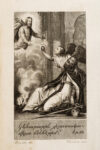GREGORY OF NAREK
GREGORY OF NAREK
Book of lamentations
Engraving. Verso of the title page. Gregory of Narek dying, at his feet the mitre and the crosier. An angel hands over his heart (his soul) to Christ. Allusion to verse 2 of chapter 12: “No desire for life. It is of the Creator of Life that I keep a burning memory.
Owing to the sacred value attributed by the Armenian people to the handwritten book, the printed book did not supersede it until the 19th century, almost three hundred years after the first publication of a book which came off the press in Venice in 1511. In its early days the printed book was, unlike manuscripts, exclusively the work of the diaspora. It was in Europe that the first works were published, initially in Venice and later in Amsterdam, where the first Bible was printed in 1666. The texts published in the 16th and 17th centuries were sometimes of religious, sometimes historical, and sometimes scholarly nature.
In the 18th century, Venice underwent a revival thanks to the considerable work of Abbot Mekhitar of Sebaste. The typography workshop on the island of San Lorenzo, opposite Venice, published a number of classical Armenian works, as well as translations of European literary works for use by students, historical and philological studies, and the 1837 dictionary, which is still the authoritative reference today.
It was only in the 19th century, however, that printing really took off with the secularization of culture which, until then, had been disseminated under the quasi-monopoly of the Church.
The replacement of the classical language by modern Armenian and the development of the press completed this evolution.
This heralded the birth of modern literature.
The printed book is no longer just an edition of the manuscript.
It now became an instrument of modern thought.
A poet and monk from the 10th century (c. 951-1009), one of the most eminent minds in religious poetry during the Armenian Middle Ages.
He spent all of his life withdrawn in his monastery and is the author of numerous odes, elegies, and homilies.
His most important work that is the most loved by Armenian people, on par with the Bible, is the ""Book of Lamentations"" known as ""Narek"".
In conversation with God, in a long monologue consisting of poetic prayers, Gregory entrusts his heart and soul to God. Every possible emotion is to be found jostling together in this book: hope, fear, love, faith, anguish, repentance and tears. Gregory wanted to redeem the sins of humankind. He held dialogues with souls caught in the trap of their sins. He has left us a remarkable work which may perhaps form the basis of the Armenian soul.
Frédéric Fringhian



